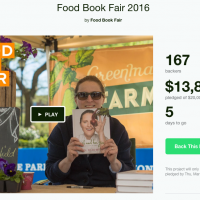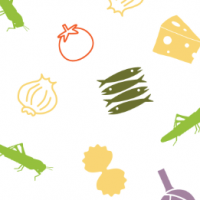New York’s first ever Food Book Fair is this weekend, May 4th-6th, in Brooklyn, at Williamsburg’s newly opened Wythe Hotel. The event is a celebration of food writing, reading, and eating and features a number of ticketed panels, free book signings, and other even more festive events. Our gracious host here at Food+Tech Connect, Danielle Gould, will be taking part in our Food+Tech+Content panel on Friday. While their focus will be on the ways food influences technology, she has agreed to let us share with you some low-tech alternatives for engaging with food knowledge. The following publications form the line-up for our Saturday Foodieodicals celebration, a gathering of our favorite food-oriented periodicals where one can eat, meet, and be merry.
 ACQTASTE
ACQTASTE
“ The voice of a food movement around the world,” Acquired Taste aims to not only change people’s perceptions of food, but also their perceptions of food publications. With a web design as sleek as their print design, you know they are at the cutting edge, at the same time ultra-hip and down to earth enough to consider the goings-on of a home kitchen.
The Art of Eating
A classic, The Art of Eating has brought the best of food, wine, restaurants, and more to readers since 1986. Thanks to the careful and caring efforts of founder Edward Behr, the magazine has become one of the most respected food publications around for its dedication to quality and obsessive focus on detail. In addition to welcoming Art of Eating to Foodieodicals, we welcome Ed Behr as the moderator for the Food+Lit+Mags panel.
DESIGN INDABA
Based in South Africa, Design Indaba is based on the idea that creativity can fuel an economic revolution in South Africa. It culls together the best of the best of people in design and other creative disciplines in the region and around the globe. The magazine did a food issue with the help of guest editor Marije Vogelzang. With her help, they picked the brains of the likes of Ferran Adria and Carolyn Steel while also considering if food can bring world peace.
Diner Journal
The unofficial host of the Food Book Fair, the team behind Diner Journal is the same team behind the lauded restaurants Diner, Marlow and Sons, and now Reynards. As much a lighthearted indie food zine as it is a serious examination of “community creativity,” Diner Journal uses food as a lens for which one can examine their social surroundings. A favorite in the Brooklyn food scene, grab Diner Journal for its friendly illustrations and hold it close always with its unique three-hole punch design.
Edible Brooklyn
Edible Brooklyn is a publication with the aim of highlighting the distinct culinary regions of this part of New York City. Emphasizing the diverse local specialties to be found throughout the borough and its favorite foods as well as the people who make them, Edible examines the flavor of the land of “Name it…We Got It.” Thanks to editorial direction by James Beard Award-winning Rachel Wharton, Edible Brooklyn’s ultimate goal is to connect all Brooklynites to increase everyone’s access to good food across the borough.
Gastronomica
Judging a book by its cover might give one the impression that Gastronomica is a food-oriented arts magazine. The truth is that this journal, published by the University of California Press, is academic in nature. You won’t be hard-pressed to find a number of our panelists on their advisory board.
Lapham’s Quarterly: The Food Issue
When editing Harper’s isn’t enough for you, break off and form your own literary magazine. Lapham’s Quarterly is the product of this endeavor that Louis Lapham undertook in 2007. Weaving together historical and contemporary primary sources to examine singular themes issue-by-issue, Lapham’s offers a unique view on our present culture. The Food Issue is a top seller and includes features by Charles Baudelaire on cake, Jonathan Swift on cannibalism, Hunter S. Thompson on breakfast, and more.
Lucky Peach
This literary embodiment of the souls of David Chang, Peter Meehan, and the various iterations of the Momofuku concept, is punk and posh, haute and bas, subtle and ostentatious. Their website calls for submissions not only of recipes, but of dirty jokes and tall tales. Sometimes it’s all about balance. In addition to welcoming Lucky Peach to Foodieodicals, we welcome Peter Meehan as a panelist for our Food+Lit+Mags panel.
Meatpaper
Two vegetarian journalists meet and decide to create a publication about meat. Rather than extolling the virtues of vegetarianism, however, founders Sasha Wizansky and Amy Standen decided to address the exploding meat culture with thoughtful articles that offered deep insights on the polarizing issue of meat consumption. While neither for or against meat, Meatpaper attempts to make sense of the “bone-deep emotions” tied up with this “divisive and universal, delicious and disturbing, funny and dead-serious” concept of carnivorousness.
Put A Egg on It!
Self-described as irreverent and printed on green stock that may evoke images of green eggs and ham, Put A Egg on It! is not just another food publication. Focused on the joys of eating with friends, affordable and easy cooking, and the importance of iron skillets, this quarterly has the added advantage of being a quite small digest. Taking advantage of the recent trend towards abrasiveness and spontaneity, this small publication packs a big punch.
Remedy Quarterly
Hearkening back to our grandmothers and the community cookbooks of old, Remedy Quarterly is a medium of memory. Austere in its design but heartfelt in its content, the small publication is a space for writers to share their stories through their encounters with food. Recipes to warm your soul fill in the rest of the pages while remedies for colds and hangovers line their website.
The Runcible Spoon
Based in Washington DC, The Runcible Spoon presents itself as part art-mag, part food-mag to get you “daydreaming about food and cooking.” Jointly run by Malaka Gharib and Claire O’neill, the zine is a free publication which attracts readers by its artful approach and its uncanny collection of stories personally curated by Gharib. They were recently featured in Saveur and the New York Times as prime examples of zines in the internet age.
Swallow Magazine
Swallow Magazine eschews all the traditional constructs of food writing in favor of its own design. A biannual hardcover, Swallow lends a breath of fresh air naturally befitting of a publication which predicted the rise of New Nordic cuisine.
White Zinfandel
White Zinfandel is a collaboration between an architecture firm and an art space to create art and write about food. Self-described as “devoted to the visual manifestation of food and culture produced within the lives of creative individuals,” the work of these artists has landed them a spot in a MoMA exhibit. Abstract, yet appealing, White Zinfandel even includes recipes.
Wilder Quarterly
A periodical for the horticulturally-inclined, Wilder Quarterly takes looks at the gardeners, growers, foragers, and general population of green thumbs among us. It presents an in-depth look at the growing world and how it reflects itself upon all facets of our lives—culture, travel, food, design, and more.





